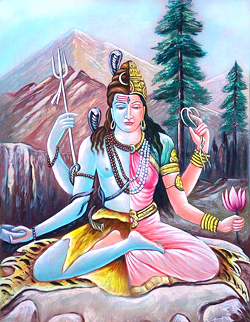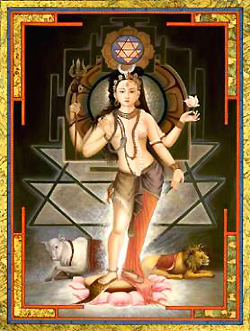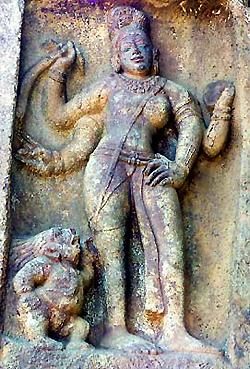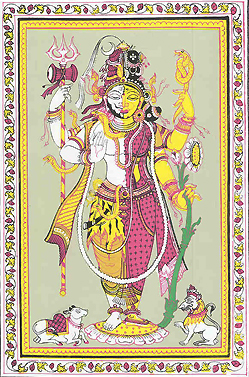Shiva Ardhanarishvara
Shiva in his hypostasis of divine, perfect androgyne
by yoga teacher Gregorian Bivolaru
 Shiva-Ardhanarishvara is one of the most well known hypostasis of Shiva. It is the mysterious expression of his divine, androgynous, bipolar nature, in which he, in his manifestation as the Supreme Masculine, is intimately fused with his own feminine half.
Shiva-Ardhanarishvara is one of the most well known hypostasis of Shiva. It is the mysterious expression of his divine, androgynous, bipolar nature, in which he, in his manifestation as the Supreme Masculine, is intimately fused with his own feminine half.
Shiva-Ardhanarishvara is the divine glorious androgyne. The profound spiritual significance of this hypostasis of Shiva is very important for the Hindu tradition. Shiva-Ardhanarishvara is the expression of the inseparable fusion between Shiva and Shakti – The Supreme Transcendent and the creative feminine energy, the masculine and feminine aspects, which then exists in a state of perfect neutrality and polar equilibrium. Shiva-Ardhanarishvara is also the divine, cosmic being that exists beyond any polarity or duality, situated above all complementary aspects that exist in manifestation.
The hypostasis of Shiva as the glorious divine androgyne is often evoked and worshipped in many parts of India; it is often present in ancient hymns dedicated to Shiva. It is based on the following mythical story:
The wise Bringi was one of the perseverant and fervent worshippers of Shiva, but he was used to worshipping only Shiva, willfully neglecting the veneration of Shakti. Through his spiritual practice, Bringi aimed to transcend the aspects of existence and it was because of that he considered it correct only to worship Shiva, separating in his mind Shiva from the manifesting feminine energy (Shakti), from which Shiva was in reality inseparable and permanently part of.
Once, the gods and sages went to stay full of devotion and adoration around Shiva and his lover Parvati, whose residence was Mount Kailassa. However, the fanatical devotee of Shiva, Bringi, began to insist, telling them that if they truly worshipped Shiva, it is necessary to stay around Shiva. Excluding totally Shakti (feminine energy) from the prayers that were offered to Shiva, Bringi abandoned, without knowing, his vital, sustaining, feminine energy, which in reality came from Shakti and which sustained him in his worship. In order to give him a spiritual lesson to remove him from this limited and foolish state, Parvati made the fanatical devotee Bringi become physically only flesh and bones. His entire feminine energy (Shakti), which he continuously rejected with an almost crazy fervor, completely left his body and caused the poor Bring to become, in a short time, very weak and lacking almost any trace of energy, so that he was no longer capable to make even the smallest movement, being already impossible to move himself. He continued, however, to pray stubbornly only to Shiva. Full of endless compassion, Shiva offered his fanatical devotee a stick as support. Taking it with veneration, Bringi became so attached to that stick that after a short time it became just like a third leg for him.
Having now this new support that was received from Shiva, Bringi continued to worship only Shiva, misunderstanding even then the meaning of this spiritual lesson to which he was submitted. Then, in order to help him to understand the inseparability between Shakti and Shiva, the lover of Shiva asked her Divine Master, Shiva, to assume for his devotee Bringi an appearance in which she was one with Shiva, and which would clearly express the inseparability that exists between Shiva and Shakti. In this situation, Shiva assumed the hypostasis of Ardhanarishvara.
 In the sacred texts of India (Purana), there are many other similar stories that explain why Shiva assumed this hypostasis. In Shiva-Purana it is said that at the beginning of creation, Brahma, the creator of the Universe gave birth first to the primordial beings, which were known as the parents of all other beings (Prajapati) and he assigned them certain responsibilities to create the different aspects that will exist in the world. They however, could not fulfill their duty, because they believed that they were just expressions of the masculine principal, convinced that they lacked the creative manifesting power.
In the sacred texts of India (Purana), there are many other similar stories that explain why Shiva assumed this hypostasis. In Shiva-Purana it is said that at the beginning of creation, Brahma, the creator of the Universe gave birth first to the primordial beings, which were known as the parents of all other beings (Prajapati) and he assigned them certain responsibilities to create the different aspects that will exist in the world. They however, could not fulfill their duty, because they believed that they were just expressions of the masculine principal, convinced that they lacked the creative manifesting power.
In these circumstance, Brahman fervently invoked Shiva for help. Knowing already what the request of Brahman was, Shiva appeared at once in the form that is called Ardhanarishvara, the one who is half-feminine and half masculine. Then it was very clear for everyone what is the true fundamental nature of Shiva and all the aspects of the universe could be created with ease, without any impediment. Therefore, every aspect that is created contains in it unity between the masculine principle and the feminine principle.
Another symbolic story is mentioned in Skanda-Purana. Here it indicates that at certain moment, Parvati, the lover of Shiva, wanted to be intimately fused, forever with Shiva, embracing him with love and also like she would always be coiled around his limbs. This passionate desire of hers was fulfilled by Shiva, who assumed for her the hypostasis of Ardhanarishvara. Because Shiva is permanently beyond any duality and transcends polarities, reference to the Supreme Absolute can be personified as and feminine aspect or a masculine aspect.
This hypostasis is associated also with the manifestation of divine grace. Shiva and Shakti are in reality an inseparable unity in the Supreme Being of God. God without form is, we could say, Paramashiva. By the free and almighty will of God the Father, beings are created and enter into the divine game of existence, in order to ecstatically discover God the Father, the one who creates all the worlds of manifestation. The feminine and effervescent dynamism of creation is called Shakti. It is an integral part of the being of God. God and his feminine, fundamental, supreme power (Shakti) create and manifest absolutely everything that exists, in an inseparable fusion that comes from the being of God the Father.
Ardhanarishvara is the hypostasis in which Shiva demonstrates his feminine, inseparable power (Shakti) as being an integrated part of his being. In this hypostasis of his divine, macrocosmic game, Shiva Ardhanarishvara, Shiva and Shakti manifest and act like a single being. This is the expression of the mysterious grace of God. Shiva and Shakti are just like ice and water, which in fact are the same substance in two different state of aggregation. Therefore, Hindu texts describe Shakti as being the lover of Shiva, because she is always inseparable from Shiva, either as the mother of Shiva, because Shiva comes from Shakti, or as the daughter of Shiva, because she is the manifestation of Shiva.
In a very inspired way, the poet Kalidasa compares the inseparability between Shiva and Shakti with the inseparability between a word and its meaning or a letter and its pronunciation. The half-masculine – half-feminine hypostasis of Shiva is an illustration of some syncretic images, in which two different but complementary aspects are represented in a completely united state. This is the representation of Shiva called Ardhanarishvara, in which the right half represents the masculine principal (Purusha) that corresponds to Shiva himself, while the left half represents the feminine principle (Prakriti) or Shakti.
 In iconography, the androgynous symbolism is characteristic to Shiva. This mysterious androgynous hypostasis of Shiva represents an artistic work of the ideas presented in the symbolic form of the lingam, which also symbolizes the unity of the masculine symbol (Lingam) with the feminine aspect (Yoni). It is also important to note that this hypostasis Shiva-Ardhanarishvara is one of the hypostasis of Shiva and not one of the hypostasis of Shakti or Devi. It is derived from the Vedic description of Shiva as having two aspects, one terrible and the other beneficial. The terrible and destructive aspect (urga) it represented by the masculine half and the feminine half represents the kind, delicate and creative aspect (Saumnya).
In iconography, the androgynous symbolism is characteristic to Shiva. This mysterious androgynous hypostasis of Shiva represents an artistic work of the ideas presented in the symbolic form of the lingam, which also symbolizes the unity of the masculine symbol (Lingam) with the feminine aspect (Yoni). It is also important to note that this hypostasis Shiva-Ardhanarishvara is one of the hypostasis of Shiva and not one of the hypostasis of Shakti or Devi. It is derived from the Vedic description of Shiva as having two aspects, one terrible and the other beneficial. The terrible and destructive aspect (urga) it represented by the masculine half and the feminine half represents the kind, delicate and creative aspect (Saumnya).
In a Hindu manuscript dating from the 15th Century, this hypostasis of Shiva, Shiva-Ardhanarishvara is very praised and it is stated that it was assumed by Shiva just to suggest to tantric practitioners what is the most profound significance of divine creation, in which the kind and terrible aspects merge and are intimately interwoven.
Classical iconography treaties, such as: Silparatna, Amsumat Veda and Supra Veda offer a great number of details about the difference of the two aspects that are brought into state of unity. Shiva-Ardhanarishvara is usually represented as having 2 arms, but there are representations of him with 3 or 4 arms, or with 8 arms, as in the temple as Darashuram. In the representation at Darashuram, Shiva-Ardhanarishvara also has 3 faces, while the other representation has only a single face.
In iconographic representations, the adaptation of the attributes that are the principle masculine and feminine characteristics in the two halves of the body is done is various ways, however the right half is always the one that represents the masculine principle and the left half the one that represents the feminine principle. If the iconographic representation has two arms, the right arm is the one that holds a human skull (kapala) or making the secret gesture of protection (Abhaya Mudra), while the left arm is lowered in a graceful position or holding a flower or mirror.
According to the Brihat-Samhita treaty, the right hand holds the trident and bow. If the representation has 3 arms, the masculine half has 2 arms and the feminine half has just one arm, which holds a mirror, flower or parrot. If the representation has 4 arms, the hands on the right side carry the weapons of Shiva, which are the battle axe (parashu), the trident (trishula), the hammer (tanka) or the rosary (akshamala), while the arms on the left side bear certain attributes of the feminine principal, such as: the blue lily or making balancing movements with the hands.
According to the work of Vishnudharmottara, the right hand has to hold the rosary and trident and the mirror and blue lotus are held in the left hands. On the forehead, the right side bears half of the third eye, which is characteristic of Shiva. The right eye has a penetrating look, while the left eye is calm and full of compassion. The arms on the right side are masculine and powerful, and the arms on the left side are delicate, graceful and feminine.
 The Brihan Narada-Purana treaty recommends that the feminine half is coloured black, while the masculine half is coloured yellow. One half should be clothed with a garment of silk and the other half should be naked. On one-half there is a crown of lotus flowers and on the other half a crown of skulls. The feminine half should be adorned with set of bracelets, having a lot of jewelry, armbands and rings, while the other half is left empty.
The Brihan Narada-Purana treaty recommends that the feminine half is coloured black, while the masculine half is coloured yellow. One half should be clothed with a garment of silk and the other half should be naked. On one-half there is a crown of lotus flowers and on the other half a crown of skulls. The feminine half should be adorned with set of bracelets, having a lot of jewelry, armbands and rings, while the other half is left empty.
Some representations of the hypostasis of Ardhanarishvara are depicted playing the musical instrument – Veena. Because playing this instrument requires the use of both hands, both halves of the body are represented as participating simultaneously to this common action, in a complete divine harmony.
According to the treaty Sakaladhikara, the representation, either with 2 arms or with 4 arms, must be made by firmly placing the right leg on the ground and keeping it straight, while the left leg is gently bent. The hands on the right side, if the representation has 4 arms, should bear the battle axe (parashu) and make the secret gesture of protection (Abhaya Mudra), the higher left hand bears a flower and the principal hand on the left side is tenderly supported on the head of a bull.
Here is a final description of the hypostasis Ardhanarishvara: “Having the form of a harmonious being, which his half-man and half-woman, with the hair on the right side braided into strands, in which is caught the moon, with the right half coloured red (aruna), wearing serpents as ornaments and a tiger skin, with the hand supported by a bull, his vehicle, and with the right leg slightly bent, and with the hands on the left side coloured black, holding a flower to his chest, with the left leg dressed in silk and having many ornaments of gold, this is Shiva the half man and half woman. Shiva-Ardhanarishvara.”
Yogaesoteric
June 2011


